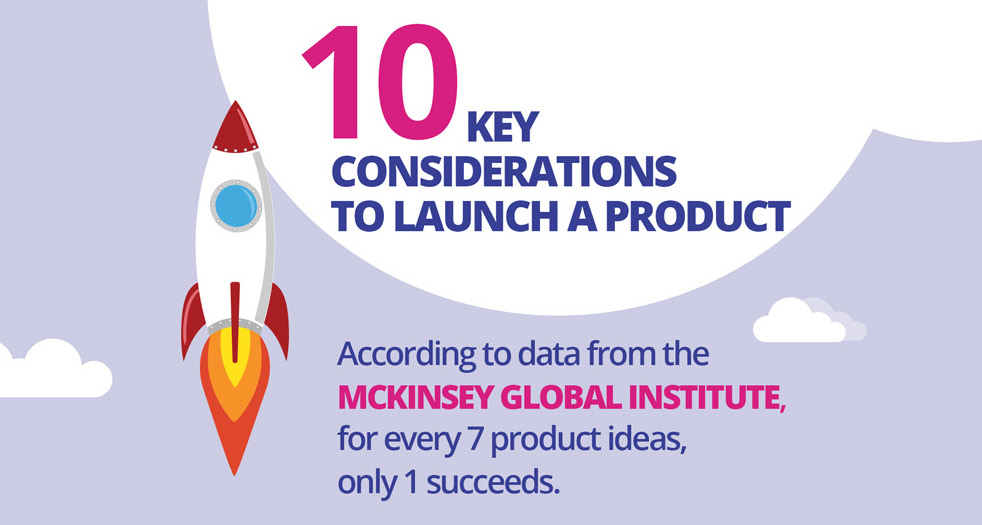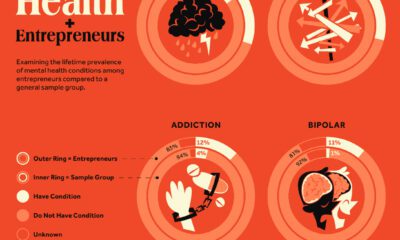Technology
10 Key Considerations Before a New Product Launch
If launching a new product was easy, then everyone would be doing it.
Instead, even as we’ve discovered in our planning for the launch of our new “coffee table” book of infographics, it requires an incredible combination of vision, deliberation, teamwork, and project management expertise to accomplish something that’s never been done before.
And even if you are lucky enough to nail many of those things, external factors can be just as deadly.
Getting a Launch Right
Today’s infographic comes from To The New, and it details 10 key points to consider before any new product launch. While it has a slant towards technology and startup products, many of the points are relevant for any new endeavor.

The fact is: launching a product can be ripe with pitfalls. Mckinsey says the chance of success for a new product is 14%.
That’s why preemptively addressing the most common slipups for new products can be an invaluable step for any prospective entrepreneur.
Ten Areas to Focus On
Here are 10 areas that experts say must be addressed to increase the odds of a successful product launch:
1. Market Analysis
According to CB Insights, 19% of startup failures were as a result of ignoring competition. Instead, the market potential must be properly analyzed and assessed to give a realistic perspective on a product launch.
2. Unclear Requirement and Strategy
If expectations for team members are unclear, then it will have a ripple effect. Product development will be delayed, and it could impact timing and profit potential.
3. Product Roadmap
This high-level plan keeps team members on the same page as product development and the launch are executed.
4. Poor Design
An easy thing to overlook – product design should be tested with extensive user research. Otherwise, users may not be aware of key features.
5. Engineering Best Practices
Following best practices for engineering helps to guarantee the product will be ready and glitch-free come launch time.
6. Poor Project Management
Unrealistic timelines, a lack of communication, and inadequate resource allocation can have a big impact on project success.
7. Funding and Capital
Getting the right amount of capital is key. Allocating it wisely to ensure project success is just as important.
8. Launch Timing
Poor timing can also lead to failure. As a result, project scheduling should be carefully planned and thought out, taking into account possible roadblocks or other adverse circumstances that could derail the plan.
9. Performance and Usability
For software or web-based products in particular: no one wants to deal with long loading times, slow responsiveness, or other usability issues. It’s best to clear these up before the product hits market.
10. Availability and Maintenance
If the product is connected to the web, the team needs to ensure that servers and security measures are taken to ensure uptime and availability.
A Final Note
Even the most powerful corporations are aware of the many potential pitfalls when launching a new product.
It’s why every CEO is so adamant that their organization maintains the focus on their core vision, competitive advantage, and current brand value proposition. If any new product does not fit all this criteria, it’s not worth the risk of the company being distracted. This is true for even the most resourceful and innovative corporations.
Luckily, and consequently, this conservatism that permeates big companies is exactly what opens up the tiny window for you to succeed with your next product launch!
Technology
Visualizing AI Patents by Country
See which countries have been granted the most AI patents each year, from 2012 to 2022.

Visualizing AI Patents by Country
This was originally posted on our Voronoi app. Download the app for free on iOS or Android and discover incredible data-driven charts from a variety of trusted sources.
This infographic shows the number of AI-related patents granted each year from 2010 to 2022 (latest data available). These figures come from the Center for Security and Emerging Technology (CSET), accessed via Stanford University’s 2024 AI Index Report.
From this data, we can see that China first overtook the U.S. in 2013. Since then, the country has seen enormous growth in the number of AI patents granted each year.
| Year | China | EU and UK | U.S. | RoW | Global Total |
|---|---|---|---|---|---|
| 2010 | 307 | 137 | 984 | 571 | 1,999 |
| 2011 | 516 | 129 | 980 | 581 | 2,206 |
| 2012 | 926 | 112 | 950 | 660 | 2,648 |
| 2013 | 1,035 | 91 | 970 | 627 | 2,723 |
| 2014 | 1,278 | 97 | 1,078 | 667 | 3,120 |
| 2015 | 1,721 | 110 | 1,135 | 539 | 3,505 |
| 2016 | 1,621 | 128 | 1,298 | 714 | 3,761 |
| 2017 | 2,428 | 144 | 1,489 | 1,075 | 5,136 |
| 2018 | 4,741 | 155 | 1,674 | 1,574 | 8,144 |
| 2019 | 9,530 | 322 | 3,211 | 2,720 | 15,783 |
| 2020 | 13,071 | 406 | 5,441 | 4,455 | 23,373 |
| 2021 | 21,907 | 623 | 8,219 | 7,519 | 38,268 |
| 2022 | 35,315 | 1,173 | 12,077 | 13,699 | 62,264 |
In 2022, China was granted more patents than every other country combined.
While this suggests that the country is very active in researching the field of artificial intelligence, it doesn’t necessarily mean that China is the farthest in terms of capability.
Key Facts About AI Patents
According to CSET, AI patents relate to mathematical relationships and algorithms, which are considered abstract ideas under patent law. They can also have different meaning, depending on where they are filed.
In the U.S., AI patenting is concentrated amongst large companies including IBM, Microsoft, and Google. On the other hand, AI patenting in China is more distributed across government organizations, universities, and tech firms (e.g. Tencent).
In terms of focus area, China’s patents are typically related to computer vision, a field of AI that enables computers and systems to interpret visual data and inputs. Meanwhile America’s efforts are more evenly distributed across research fields.
Learn More About AI From Visual Capitalist
If you want to see more data visualizations on artificial intelligence, check out this graphic that shows which job departments will be impacted by AI the most.
-

 Mining1 week ago
Mining1 week agoGold vs. S&P 500: Which Has Grown More Over Five Years?
-

 Markets2 weeks ago
Markets2 weeks agoRanked: The Most Valuable Housing Markets in America
-

 Money2 weeks ago
Money2 weeks agoWhich States Have the Highest Minimum Wage in America?
-

 AI2 weeks ago
AI2 weeks agoRanked: Semiconductor Companies by Industry Revenue Share
-

 Markets2 weeks ago
Markets2 weeks agoRanked: The World’s Top Flight Routes, by Revenue
-

 Countries2 weeks ago
Countries2 weeks agoPopulation Projections: The World’s 6 Largest Countries in 2075
-

 Markets2 weeks ago
Markets2 weeks agoThe Top 10 States by Real GDP Growth in 2023
-

 Demographics2 weeks ago
Demographics2 weeks agoThe Smallest Gender Wage Gaps in OECD Countries














